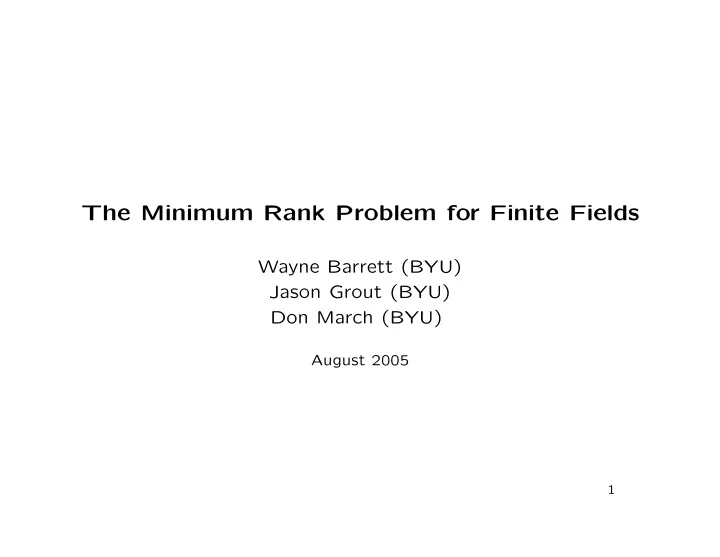

The Minimum Rank Problem for Finite Fields Wayne Barrett (BYU) Jason Grout (BYU) Don March (BYU) August 2005 1
References Barrett, van der Holst, Loewy, Graphs whose Minimal Rank is Two, Electronic Journal of Linear Algebra, volume 11 (2004), pp. 258–280 Barrett, van der Holst, Loewy, Graphs whose Minimal Rank is Two, Electronic Journal of Linear Algebra, volume 11 (2004), pp. 258–280 Barrett, Grout, March, The Minimal Rank Problem over a Finite Field, in preparation. 2
Example of S ( F, G ) d 1 ∗ ∗ ∗ 0 1 3 ∗ ∗ ∗ d 2 0 ∗ ∗ ∗ ∗ d 3 ⇐ ⇒ 5 ∗ ∗ ∗ ∗ d 4 0 0 ∗ ∗ d 5 2 4 d 1 , . . . d 5 ∈ F . Replace *s with any nonzero elements of F . 3
Example: Computing min rank in R , F 2 , F 3 F = R , F 3 : 1 1 1 1 0 0 0 0 0 0 1 1 1 1 0 1 1 1 1 0 0 0 0 0 0 1 1 1 1 0 A = 1 1 1 1 0 + 0 0 1 1 1 = 1 1 2 2 1 1 1 1 1 0 0 0 1 1 1 1 1 2 2 1 0 0 0 0 0 0 0 1 1 1 0 0 1 1 1 rank A = 2, so mr( R , G ) = 2 and mr( F 3 , G ) = 2. ∈ S ( F 2 , G ). But in F 2 , 2 = 0, so A / 4
Example: Computing min rank in F 2 F = F 2 : 1 1 1 0 d 1 1 1 1 0 d 2 Any A ∈ S ( F 2 , G ) has form 1 1 1 1 . d 3 1 1 1 d 4 1 0 0 1 1 d 5 1 1 0 A [145 | 235] = 1 1 1 has determinant 1 so rank A ≥ 3. 0 1 d 5 Therefore mr( F 2 , G ) ≥ 3. 5
Idea of Algorithm To find the graphs characterizing { G | mr( F, G ) ≤ k } : 1. Construct all matrices A of rank ≤ k over F . Use the fact A = U t BU ⇐ ⇒ rank( A ) ≤ k. ( B is k × k , rank k ; U is k × n .) 2. Return non-isomorphic graphs corresponding to matrices. Problem: Too many matrices. Solution: We only need the zero-nonzero patterns for the ma- trices. Be smarter by understanding A = U t BU better. 6
A = U t BU Feature/operation on U Effect on graph correspond- ing to A Column in U vertex in graph Column in U isotropic wrt B zero entry for the vertex on di- agonal Column in U not isotropic nonzero entry for the vertex on wrt B diagonal Two columns orthogonal no edge between corresponding wrt B vertices (zero matrix entry) Two columns not orthogo- edge between corresponding nal wrt B vertices (nonzero matrix entry) 7
A = U t BU Feature/operation on U Effect on graph correspond- ing to A Duplicate columns independent set, vertices have (isotropic) same neighbors Duplicate columns clique, vertices have same (non-isotropic) neighbors Columns multiples of each corresponding vertices have other same neighbors (remember, only the zero-nonzero pattern is needed, and there are no zero divisors in F ) Interchanging two columns relabel vertices 8
⇐ ⇒ • black vertex ⇐ ⇒ clique • white vertex ⇐ ⇒ independent set • edge ⇐ ⇒ all possible edges • cliques or independent sets can be empty 9
Algorithm To find the graphs characterizing { G | mr( F, G ) ≤ k } : 1. Find a maximal set of k -dimension vectors in F such that no vector is a multiple of any other. These are columns in U . 2. Construct all interesting matrices A of rank ≤ k over F . Use the fact A = U t BU ⇐ ⇒ rank( A ) ≤ k. ( B is k × k , rank k ; U is k × n .) 3. Return non-isomorphic marked graphs corresponding to ma- trices. 10
Characterizing marked graphs for F 3 Rank Vertices Edges 2 5 5 2 5 4 3 14 54 4 41 525 4 41 528 5 122 4 860 6 365 44 100 6 365 44 109 7 1094 398 034 11
Finding forbidden subgraphs Let S be the set of marked subgraphs of our characterizing graphs. For each (normal) graph G 1. Construct the set T of possible marked graphs for G (can do this in exponential time). 2. If S ∩ T � = ∅ , then G is a substitution graph of the character- izing graphs. 3. If S ∩ T = ∅ , then G is forbidden. 12
Open Questions • Given a finite field F and positive integer k , what is a good upper bound for the number of vertices in minimal forbidden subgraphs? • Is the bound 8 for F = F 2 and k = 3? • Let G be any graph and let F be a finite field, char F � = 2. Is mr( R , G ) ≤ mr( F, G )? (true if mr( R , G ) ≤ 3). 13
Recommend
More recommend